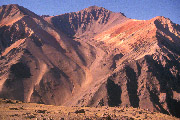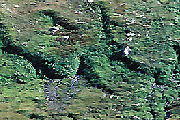 |
|
|
|
|
|
Rockglaciers Rockglaciers are widespread permafrost phenomena. Their body consists of rocks and ice, which slowly moves downslope. During the last decades, global warming has led to an upward shift of the lower limit of permafrost in most mountain areas worldwide. Consequently, many formerly active rockglaciers are getting inactive. Hence, rockglaciers can be used as paleoclimatic archives: E.g. rockglaciers formed in the Upper Pleistocene can be found several hundert meters below the modern permafrost limit, indicating the cooler conditions of this former period. Hence, an approximate Upper Pleistocene permafrost limit can be reconstructed. |
1 - Rockglacier in an alpine desert (Chile, Elqui-Valley,
30∞S, 4300 m), indicating permafrost. |
Solifluction (lobes, cover-beds) Solifluction can appear without permafrost. Depending on the seasonal depth of soil frost, an uppermost layer up to several decimeter thick, moves downslopes. This leads to the fossilisation of the soils in front. Subsequently, fossil soils and solifluction layers alternate, indicating the variable climatic conditions. |
2 - Solifluction lobes, Furka (Switzerland) |
29 August 2011 |
||
| |
||


